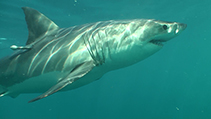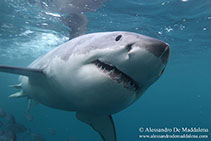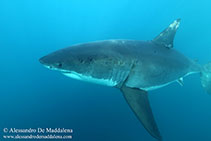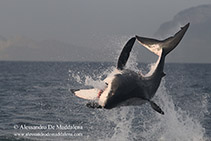Carcharodon carcharias (Linnaeus, 1758)
Great white shark
添加你自己的观测位置在 Fish Watcher
| Native range | All suitable habitat | Point map | Year 2050 |

|
| This map was computer-generated and has not yet been reviewed. |
| Carcharodon carcharias AquaMaps Data sources: GBIF OBIS |
New Zealand country information
Common names:
Great white shark, Great white shark, Mango-taniwha
Occurrence: native
Salinity: brackish
Abundance: | Ref:
Importance: | Ref:
Aquaculture: | Ref:
Regulations: | Ref:
Uses: gamefish: yes;
Comments: First record in the Chathams Island (Ref. 45493). Found throughout New Zealand and are attracted to colonies of seals and aggregations of other marine mammals in the cooler southern waters of the country. The abundance of the prey animals in the southern waters probably accounts for the high number of human attacks in the southern South Island, the Chatham Islands and Campbell Island. Voucher specimen(s) held at the NMNZ (Ref. 5755). Also Ref. 247, 8879, 9987, 26938 and 43278.
National Checklist:
Country Information: https://www.cia.gov/library/publications/resources/the-world-factbook/geos/nz.html
National Fisheries Authority: http://www.fish.govt.nz/
Occurrences: Occurrences Point map
Main Ref: Cox, G. and M. Francis, 1997
National Database:
Occurrence: native
Salinity: brackish
Abundance: | Ref:
Importance: | Ref:
Aquaculture: | Ref:
Regulations: | Ref:
Uses: gamefish: yes;
Comments: First record in the Chathams Island (Ref. 45493). Found throughout New Zealand and are attracted to colonies of seals and aggregations of other marine mammals in the cooler southern waters of the country. The abundance of the prey animals in the southern waters probably accounts for the high number of human attacks in the southern South Island, the Chatham Islands and Campbell Island. Voucher specimen(s) held at the NMNZ (Ref. 5755). Also Ref. 247, 8879, 9987, 26938 and 43278.
National Checklist:
Country Information: https://www.cia.gov/library/publications/resources/the-world-factbook/geos/nz.html
National Fisheries Authority: http://www.fish.govt.nz/
Occurrences: Occurrences Point map
Main Ref: Cox, G. and M. Francis, 1997
National Database:
Common names from other countries
分类 / Names 俗名 | 同种异名 | Catalog of Fishes(属, 种) | ITIS | CoL | WoRMS | Cloffa
Elasmobranchii 板鳃亚纲 (鲨鱼与 鱼) (sharks and rays) > Lamniformes (Mackerel sharks) > Lamnidae (Mackerel sharks or white shark)
Etymology: Carcharodon: carchar-, presumably referring to Carcharias (Odontaspidae); odon (Gr.), tooth, “Teeth as in Carchari[a]s, serrated on both edges” (See ETYFish); carcharias: From the Ancient Greek karkharías, shark, derived from kárkharos, sharp or jagged, referring to its teeth (“dentibus serratus”) (See ETYFish).
More on author: Linnaeus.
Etymology: Carcharodon: carchar-, presumably referring to Carcharias (Odontaspidae); odon (Gr.), tooth, “Teeth as in Carchari[a]s, serrated on both edges” (See ETYFish); carcharias: From the Ancient Greek karkharías, shark, derived from kárkharos, sharp or jagged, referring to its teeth (“dentibus serratus”) (See ETYFish).
More on author: Linnaeus.
Environment: milieu / climate zone / depth range / distribution range 生态学
海洋; 半咸淡水; 海洋洄游的 (Ref. 51243); 深度上下限 0 - 1280 m (Ref. 106604), usually 0 - 250 m (Ref. 55270). 亞熱帶的; 61°N - 58°S, 180°W - 180°E
分布 国家 | FAO区域 | 生态系 | 标本纪录 | Point map | 简介 | Faunafri
Worldwide. Very wide-ranging in most oceans; among the greatest habitat and geographic range of any fish, tolerating temperatures of 5°-25°C.
四海為家的人, 大部份南北溫帶。 西大西洋: 加拿大紐芬蘭到阿根廷; 也墨西哥灣北方部,巴哈馬,古巴與小安地列斯群島.(參考文獻 26938) 東大西洋: 法國到南非, 包括地中海。 印度洋: 紅海,塞錫爾群島, 南非; 也留尼旺島與模里西斯.(參考文獻 33390) 西太平洋: 西伯利亞到紐西蘭與馬紹爾群島; 也澳洲南方部.(參考文獻 26938) 中太平洋: 夏威夷。 東太平洋: 阿拉斯加到智利。 國際間的買賣合作, 澳洲 ( 引用 附錄 3, 自從 28.5.2003 以後; 公分 附錄 I 與 2).
四海為家的人, 大部份南北溫帶。 西大西洋: 加拿大紐芬蘭到阿根廷; 也墨西哥灣北方部,巴哈馬,古巴與小安地列斯群島.(參考文獻 26938) 東大西洋: 法國到南非, 包括地中海。 印度洋: 紅海,塞錫爾群島, 南非; 也留尼旺島與模里西斯.(參考文獻 33390) 西太平洋: 西伯利亞到紐西蘭與馬紹爾群島; 也澳洲南方部.(參考文獻 26938) 中太平洋: 夏威夷。 東太平洋: 阿拉斯加到智利。 國際間的買賣合作, 澳洲 ( 引用 附錄 3, 自從 28.5.2003 以後; 公分 附錄 I 與 2).
Length at first maturity / 大小 / 重量 / 年龄
Maturity: Lm 475.0, range 450 - 500 cm
Max length : 640 cm TL 雄鱼/尚未辨别雌雄; (Ref. 12489); 最大体重: 0.00 g; 最大年龄: 36 年 (Ref. 31395)
Max length : 640 cm TL 雄鱼/尚未辨别雌雄; (Ref. 12489); 最大体重: 0.00 g; 最大年龄: 36 年 (Ref. 31395)
简单描述 检索表 | 型态特徵 | 形态测量图
背棘 (总数) : 0; 臀棘: 0. A huge, spindle-shaped shark with conspicuous black eyes, a blunt, conical snout and large, triangular, saw-edged teeth (Ref. 5578). First dorsal-fin origin usually over the pectoral-fin inner margins (Ref. 43278, 6871). Caudal fin crescentic (Ref. 247). Lead-grey to brown or black above, lighter on sides, and abruptly white below (Ref. 6851). Black spot at rear pectoral fin base (Ref. 6851).
极大, 纺锤形的鲨鱼有显着的黑眼珠,一个钝又锥形吻与大的,三角形的,和边缘锯状的齿.(参考文献 5578) 第一背鳍起源通常在胸鳍内缘上面。 (参考文献 43278,6871) 尾鳍新月形的.(参考文献 247) 铅灰色到褐色或黑色的上方, 两边颜色较淡, 与腹面醒目的白色.(参考文献 6851) 在后面的胸鳍基底的黑色斑点.(参考文献 6851)
极大, 纺锤形的鲨鱼有显着的黑眼珠,一个钝又锥形吻与大的,三角形的,和边缘锯状的齿.(参考文献 5578) 第一背鳍起源通常在胸鳍内缘上面。 (参考文献 43278,6871) 尾鳍新月形的.(参考文献 247) 铅灰色到褐色或黑色的上方, 两边颜色较淡, 与腹面醒目的白色.(参考文献 6851) 在后面的胸鳍基底的黑色斑点.(参考文献 6851)
Primarily a coastal and offshore inhabitant of continental and insular shelves, but may also occur off oceanic islands far from land (Ref. 247, 43278, 58302). Often close inshore to the surf line and even penetrates shallow bays (Ref. 247). Maximum depth of 700 fathoms (or 1280 m) reported by Bigelow & Schroeder, 1948 is erroneous (Francis et al., 2012 in Ref. 106604). Pelagic, capable of migration across oceanic regions (Ref. 58302). Usually solitary or in pairs but can be found in feeding aggregations of 10 or more; does not form schools (Ref. 247). Feeds on bony fishes, sharks, rays, seals, dolphins and porpoises, sea birds, carrion, squid, octopi and crabs (Ref. 5578) and whales (Ref. 32140). Ovoviviparous, embryos feeding on yolk sac and other ova produced by the mother (Ref. 43278, 50449). Number of young born per litter, 7 (Ref. 31395) to 14 (Ref. 26346). Reported by some experts to attack humans which they mistake for their normal prey (Ref. 47). Most attacks occur in estuaries. Caught by big-game anglers and line boats for its jaws (Ref. 5578). Reported to cause poisoning (Ref. 4690). Flesh is utilized fresh, dried-salted, and smoked for human consumption, the skin for leather, liver for oil, carcass for fishmeal, fins for shark-fin soup, and teeth and jaws for decorations (Ref. 13574). Maximum total length is leading to much speculation and some measurements are found to be doubtful. Possibly to 6.4 m or more in length (Ref. 43278), considered the world's largest predator with a broad prey spectrum. The record of 10.98 m is incorrect (Ref. 13574). Maximum total length for male from Ref. 91029. Sometimes considered the most dangerous shark in the world (Ref. 26938). Maximum depth reported taken from Ref. 86942.
主要地一个大陆棚与岛屿棚的海岸与外海栖居动物, 也但是可能出现大洋性岛屿外远离土地.(参考文献 247) 时常近岸到碎浪区甚至深入浅湾.(参考文献 247) 通常独居性的或成对但是在 10个或更多的觅食群集中被发现于; 不会形成鱼群.(参考文献 247) 吃硬骨鱼类,鲨鱼,魟,海豹,海豚与鼠海豚,海鸟,腐肉,乌贼,章鱼与螃蟹 (参考文献 5578) 与鲸。 (参考文献 32140) 卵胎生的, 胚胎吃产生于母亲的卵黄囊与其他的卵.(参考文献 50449) 每胎被出生的幼鱼数目, 7(参考文献 31395) 到 14.(參考文獻 26346) 藉著一些專家報告攻擊人類他們誤認為他們的正常獵物那一個。 (參考文獻 47) 大多數的攻擊出現在河口。 對於它的顎被大-比賽垂釣者與線船捕獲了。 (參考文獻 5578) 報告引起毒害。 (參考文獻 4690) 肉是生鮮利用,乾燥鹽醃, 而且煙燻了供人類消費,皮膚用做皮革,肝臟用於製造魚肝油,殘骸用於魚粉,鰭用於魚翅湯與齒與顎用於裝飾。 (參考文獻 13574) 可能地到 8 公尺長, 被認為是世界最大的掠食者具有一個寬的獵食幅度。 10.98 公尺的記錄是不正確的。 (參考文獻 13574) 有時被認為是最危險的鯊魚世界上。 (參考文獻 26938)
主要地一个大陆棚与岛屿棚的海岸与外海栖居动物, 也但是可能出现大洋性岛屿外远离土地.(参考文献 247) 时常近岸到碎浪区甚至深入浅湾.(参考文献 247) 通常独居性的或成对但是在 10个或更多的觅食群集中被发现于; 不会形成鱼群.(参考文献 247) 吃硬骨鱼类,鲨鱼,魟,海豹,海豚与鼠海豚,海鸟,腐肉,乌贼,章鱼与螃蟹 (参考文献 5578) 与鲸。 (参考文献 32140) 卵胎生的, 胚胎吃产生于母亲的卵黄囊与其他的卵.(参考文献 50449) 每胎被出生的幼鱼数目, 7(参考文献 31395) 到 14.(參考文獻 26346) 藉著一些專家報告攻擊人類他們誤認為他們的正常獵物那一個。 (參考文獻 47) 大多數的攻擊出現在河口。 對於它的顎被大-比賽垂釣者與線船捕獲了。 (參考文獻 5578) 報告引起毒害。 (參考文獻 4690) 肉是生鮮利用,乾燥鹽醃, 而且煙燻了供人類消費,皮膚用做皮革,肝臟用於製造魚肝油,殘骸用於魚粉,鰭用於魚翅湯與齒與顎用於裝飾。 (參考文獻 13574) 可能地到 8 公尺長, 被認為是世界最大的掠食者具有一個寬的獵食幅度。 10.98 公尺的記錄是不正確的。 (參考文獻 13574) 有時被認為是最危險的鯊魚世界上。 (參考文獻 26938)
Life cycle and mating behavior 成熟度 | 繁殖 | 产卵场 | 卵 | 孕卵数 | 仔鱼
Exhibit ovoviparity (aplacental viviparity), with embryos feeding on other ova produced by the mother (oophagy) after the yolk sac is absorbed (Ref. 50449). Up to 10, possibly 14 young born at 120-150 cm (Ref. 26346). Distinct pairing with embrace (Ref. 205). Male and female may swim in parallel while copulating (Ref. 28042, 49562).四海為家的人, 大部份南北溫帶。 西大西洋: 加拿大紐芬蘭到阿根廷; 也墨西哥灣北方部,巴哈馬,古巴與小安地列斯群島.(參考文獻 26938) 東大西洋: 法國到南非, 包括地中海。 印度洋: 紅海,塞錫爾群島, 南非; 也留尼旺島與模里西斯.(參考文獻 33390) 西太平洋: 西伯利亞到紐西蘭與馬紹爾群島; 也澳洲南方部.(參考文獻 26938) 中太平洋: 夏威夷。 東太平洋: 阿拉斯加到智利。 國際間的買賣合作, 澳洲 ( 引用 附錄 3, 自從 28.5.2003 以後; 公分 附錄 I 與 2).
主要参考文献
Upload your references | 参考文献 | 合作者 : Compagno, Leonard J.V. | 合作者
Compagno, L.J.V., 1984. FAO Species Catalogue. Vol. 4. Sharks of the world. An annotated and illustrated catalogue of shark species known to date. Part 1 - Hexanchiformes to Lamniformes. FAO Fish. Synop. 125(4/1):1-249. Rome, FAO. (Ref. 247)
世界自然保护联盟红皮书 (Ref. 130435: Version 2024-2)
次级保育类动物, 见 IUCN 红皮书 (VU) (A2bd); Date assessed: 07 November 2018
人类利用
渔业: 低经济; 游钓鱼种: 是的
FAO(渔业: 产生, 物种外形; publication : search) | FishSource | 周边海洋
更多信息
Population dynamics
成长参数
Max. ages / sizes
Length-weight rel.
Length-length rel.
体长-频率
Mass conversion
入添量
丰度
成长参数
Max. ages / sizes
Length-weight rel.
Length-length rel.
体长-频率
Mass conversion
入添量
丰度
Physiology
Body composition
Nutrients
耗氧量
游泳类型
游泳速度
Visual pigments
Fish sound
Diseases & Parasites
Toxicity (LC50s)
Body composition
Nutrients
耗氧量
游泳类型
游泳速度
Visual pigments
Fish sound
Diseases & Parasites
Toxicity (LC50s)
工具
Bio-Quiz | E-book | 野外调查 | 检索表 | 长度- 频率 Wizard | 生活- 历史的工具 | 分布图 | Classification Tree
| Catch-MSY |
特别资料
下载 XML
网络资源
Aquatic Commons | BHL | Cloffa | BOLDSystems | Websites from users | 核实 FishWatcher | CISTI | Catalog of Fishes(属, 种) | DiscoverLife | DORIS | ECOTOX | Faunafri | Fishtrace | GenBank(基因组, 核苷酸) | GloBI | GOBASE | | Google Books | Google Scholar | Google | IGFA World Record | MitoFish | 国家资料库 | Otolith Atlas of Taiwan Fishes | PubMed | Reef Life Survey | Scirus | SeaLifeBase | 树状分类阶层 | Wikipedia(转至, 搜寻) | World Records Freshwater Fishing | 动物学的记录
Estimates based on models
Preferred temperature (Ref. 115969): 11.3 - 24.9, mean 18.1 (based on 4368 cells).
Phylogenetic diversity index (Ref. 82804): PD50 = 1.0313 [Uniqueness, from 0.5 = low to 2.0 = high].
Bayesian length-weight: a=0.00871 (0.00625 - 0.01214), b=3.05 (2.96 - 3.14), in cm Total Length, based on LWR estimates for this species (Ref. 93245).
营养阶层 (Ref. 69278): 4.5 ±0.4 se; based on diet studies.
回复力 (Ref. 120179): 非常低的, 最小族群倍增时间超过14 年 (K=0.06; tm=8-12; tmax=36; Fec=7).
Fishing Vulnerability (Ref. 59153): Very high vulnerability (86 of 100).
Climate Vulnerability (Ref. 125649): High vulnerability (60 of 100).







